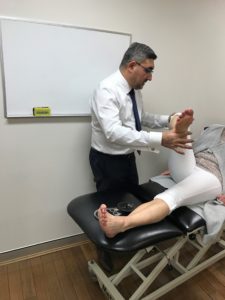Dr. Abbie Clinics featured in Sydney Morning Herald
- Edgard Diaz
- October 30, 2017
- News
The story below was recently in a special advertising feature in the Sydney Morning Herald (Friday, 27 October 2017). A link to the full feature is here.
Put your best foot forward

Feet are a complicated part of the body. They carry our weight on 26 bones, 33 joints and 100 tendons. Nerves and blood vessels from the feet need to reach all the way to our heart and our brain.
When our feet go wrong it can impact the whole body. Abnormal foot structures can cause problems as we walk or run, leading to changes in the ankles, knees, hips, pelvis and spinal column – creating pain.
The study of how the body moves is called biomechanics. Podiatrists have found that pain in the hips or back problems is often be caused by abnormally functioning feet.
Wear and tear patterns on the soles of your shoes can reveal whether or not you have a potential problem.
Dr Abbie Najjarine is an internationally renowned podiatric biomechanical practitioner. At Dr. Abbie Clinics in Kirrawee and around New South Wales, their podiatrists check the movement of the feet using a biomechanical assessment system designed by Dr Najjarine called the Najjarine Assessment System (NAS). This is used to assess and pinpoint the cause of a patient’s movement problems.
“We take a holistic approach to eliminating pain, fixing issues and ultimately improving well-being by looking at the whole body as an engineering structure, which like buildings have foundations – the feet. If the foundations are faulty then the building will get cracks,” said Dr Najjarine.
“A lot of back and hip problems relate foundation flaws. For example, pronation, or flat feet, is the foot rolling inwards at the ankle to compensate for the ground. This leads to postural problems, muscle wasting and muscles that end up tightening, resulting in conditions like bursitis, inflammation and degenerative changes in the foot, knees, hips and back pain,” said Dr Najjarine
“Before podiatry I was an engineer and engineering principals are behind the NAS system, combined with my own personal leg pain experiences when growing up. Now this six step assessment provides the practitioner with an understanding of the cause of the patient’s condition,” he said.
Dr Najjarine has trained over 20,000 students and practitioners world-wide and practitioners have reported to have achieved great results with the NAS technique.
Following assessment treatment often includes prescribing custom-designed orthotics, which are designed individually, just like a pair of glasses are designed for the wearer.
“There are 28 version of orthotic devices with about hundred different modifications that can be added as every single person has a different alignment and condition,” explains Dr Najjarine.
“Other treatments we use include dry needling, stretching programs, strengthening programs, foot, knee and hip joint mobilization, which is very affective with orthotics. Also we use glucose injections shock wave therapy and postural and gait analysis correction.”
Once patients fix their feet, many find they stop experiencing pain in other parts of their body. You do not need a referral to see a podiatrist however it is always recommended that anyone experiencing pain also works with their GP to rule out any other conditions.


